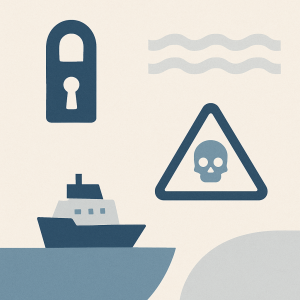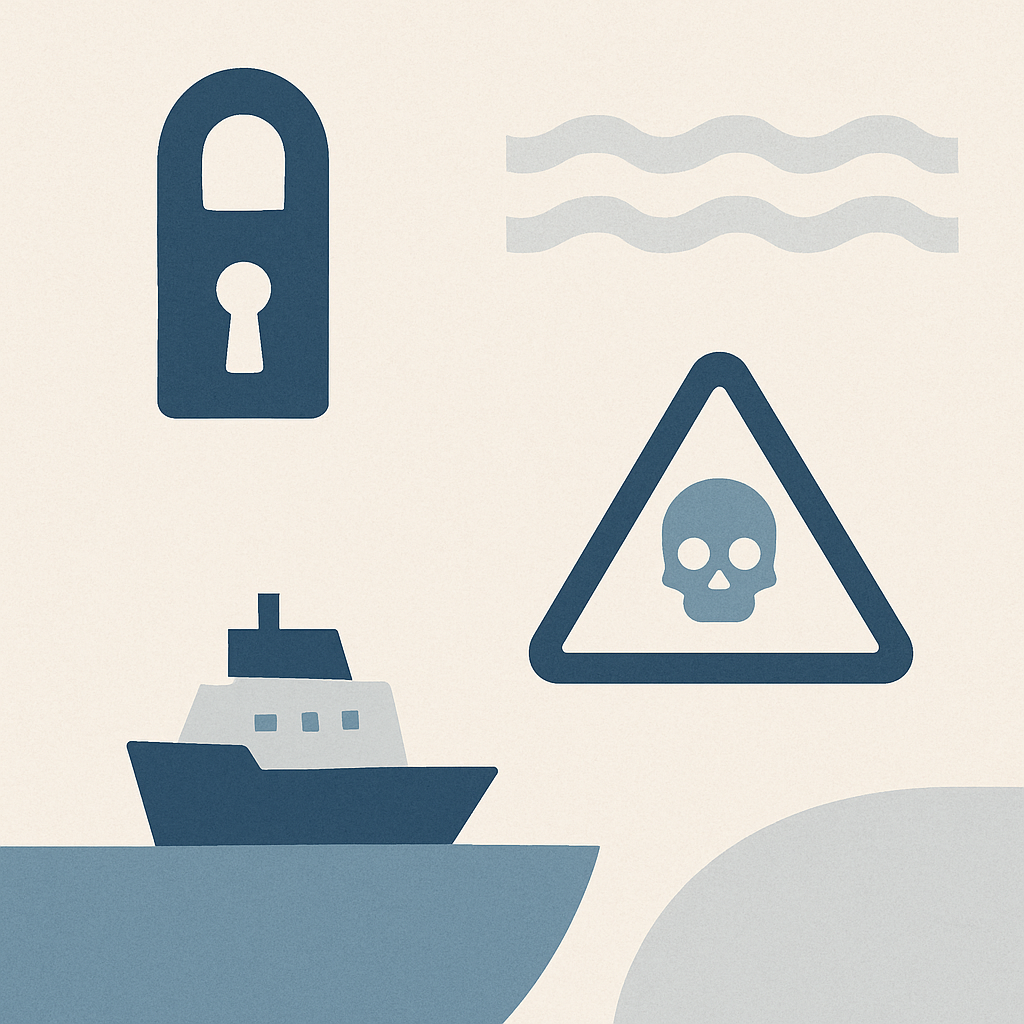 Before navigating through piracy-prone waters, every ship must take serious precautions. Explore the top 7 critical considerations to ensure crew safety, regulatory compliance, and ship security in this essential guide.
Before navigating through piracy-prone waters, every ship must take serious precautions. Explore the top 7 critical considerations to ensure crew safety, regulatory compliance, and ship security in this essential guide.
Modern shipping lanes cross some of the most volatile and piracy-affected waters in the world. From the Gulf of Guinea to the Gulf of Aden, maritime piracy—though reduced in recent years—remains a very real threat. For crew members, ship operators, and shipping companies, entering a piracy-prone area requires more than vigilance—it demands preparation, coordination, and compliance with international protocols.
This article explores the top 7 critical considerations before navigating piracy hotspots, offering practical guidance and real-world examples to help maritime professionals protect lives and cargo.
Why Piracy Awareness Still Matters in Maritime Operations
According to the International Maritime Bureau (IMB) 2023 report, there were 120 reported incidents of piracy and armed robbery globally—an increase from the previous year. While the Indian Ocean saw a decline, hotspots like the Gulf of Guinea and Southeast Asia remain high-risk zones.
Piracy not only endangers crew safety but also affects insurance premiums, voyage planning, and compliance with flag-state regulations. The IMO, ICS, and BIMCO all emphasize proactive anti-piracy measures under international law, such as SOLAS Chapter XI-2, ISPS Code, and Best Management Practices (BMP5).
1- Risk Assessment and Route Planning
Before a ship even approaches a known piracy zone, a detailed risk assessment must be conducted. This involves:
- Reviewing historical piracy incident data from IMB Live Piracy Map
- Cross-checking with Maritime Security Charts (Q6099, Q6111)
- Considering seasonal trends, such as increased attacks during calm weather
Planners must also evaluate the necessity of the route. Can the ship reroute to avoid hotspots, even if slightly longer?
Case Example: In 2021, a product tanker changed course to avoid the Somali Basin after intelligence from UKMTO (UK Maritime Trade Operations) showed pirate skiff activity. The diversion cost 1.5 days but avoided a potential boarding.
2- Ship Hardening and Physical Security Measures
Under BMP5, vessels are advised to implement a range of passive and active deterrents:
- Razor wire installation around gunwales
- Secure all external doors and hatches
- Water cannons, high-pressure hoses, and manual fire pumps
- Enhanced lighting and night vision devices
Ships should create a Citadel (safe room) stocked with water, food, and communication equipment where crew can retreat in case of boarding.
“Pirates scan for easy targets. Razor wire, dummy cameras, and visible patrols make a difference,” said Capt. Olivier, a master on a chemical tanker transiting West Africa.
3- Crew Briefing and Training
The best equipment is useless without a trained crew. Prior to entering a high-risk area, conduct drills and reviews of:
- Anti-piracy Watchkeeping procedures
- Emergency lockdown routines
- Alarm signals (internal vs external)
- Roles within the Citadel
STCW Convention Section A-VI/6 requires security training for all seafarers working on ISPS-compliant vessels. Drills should reflect real scenarios, such as attempted boarding or fake fishing boats approaching.
4- Coordination with Naval and Security Authorities
Ships should register their voyage through high-risk zones with relevant authorities:
- UKMTO for Indian Ocean, Red Sea, Gulf of Aden
- MSCHOA (EU NAVFOR) for Somali Basin
- MDAT-GOG for Gulf of Guinea
These centres provide daily threat updates and real-time alerts. Ships are often guided via Voluntary Reporting Areas (VRA) where naval assets can respond faster.
Tip: Establish a standard communication script for suspicious contacts. Never reveal cargo, route, or crew size over open channels.
5- Use of Private Maritime Security Companies (PMSCs)
In some high-risk zones, especially the Indian Ocean, shipping companies hire armed guards or unarmed security teams via PMSCs. However, there are legal, ethical, and insurance implications:
- Weapons must be declared and licensed
- Rules for use of force must be clear and in line with flag state laws
- Coordination with port state control to prevent legal issues upon arrival
Guidance from BIMCO’s GUARDCON contract standardizes the hiring and conduct of PMSCs.
6- Reporting Protocols and Emergency Response Plans
Vessels should be familiar with real-time incident reporting procedures:
- Initial report to UKMTO or MDAT-GOG
- Follow-up reports to IMB Piracy Reporting Centre
- Company Security Officer (CSO) coordination
Ships must also have an updated Ship Security Plan (SSP) with clear escalation protocols:
- When to activate SSAS (Ship Security Alert System)
- Bridge response and evasive maneuvers
- Communication tree to alert owners, managers, and insurers
Real Case: In a 2022 Gulf of Guinea incident, a ship triggered the SSAS and locked down the crew in the Citadel. Naval assets responded within 3 hours, and no crew injuries occurred—largely due to strict protocol adherence.
7- Insurance and Legal Considerations
Before entering a high-risk area, ships must ensure:
- War risk insurance is activated
- Additional premiums (HRA surcharges) are calculated
- P&I Club endorsements cover crew injuries or hostage events
London-based insurance group IUMI and Lloyd’s of London maintain separate frameworks for high-risk waters. Failure to notify insurers can result in claim denial.
Legal guidance must also be available in case of detainment of crew or use of armed guards. Shipowners are advised to keep documentation of training records, BMP5 compliance, and voyage tracking logs.
–
Frequently Asked Questions (FAQ)
Is piracy still a major threat today?
Yes. While Somali piracy has declined, West Africa, Southeast Asia, and the Red Sea remain hotspots with ongoing incidents.
What are BMP5 guidelines?
BMP5 is the latest Best Management Practices document offering detailed anti-piracy measures for ships transiting high-risk waters, jointly issued by industry stakeholders like BIMCO, ICS, and INTERTANKO.
Are armed guards mandatory?
No, but in certain high-risk areas, they are highly recommended. The decision depends on the shipowner, flag state, and charter party agreement.
What is a Citadel?
A secure location within the ship where crew can shelter in case of a pirate boarding. It should be stocked with emergency supplies and equipped with communication tools.
Do pirates only target big ships?
No. While tankers and bulk carriers are common targets, even smaller general cargo or fishing vessels have been attacked—especially if they appear poorly secured.
Conclusion: Preparedness Saves Lives
Navigating through a piracy-prone area is never routine. Every passage demands alertness, preparation, and structured planning. From route selection and crew drills to compliance with international frameworks, every layer adds protection.
Shipowners, Masters, and Chief Officers must treat piracy readiness with the same priority as collision avoidance or fire safety. Because when an attack does happen, it escalates fast—and only those who prepare well can respond calmly and effectively.
The good news? With proper protocols, international coordination, and crew training, most pirate attacks can be deterred or managed without loss of life or cargo.
References
- BIMCO. BMP5: Best Management Practices to Deter Piracy. bimco.org
- International Maritime Bureau (IMB). Live Piracy Report and Annual Reviews. icc-ccs.org
- IMO. SOLAS Chapter XI-2 and ISPS Code. imo.org
- UKMTO. Voluntary Reporting Areas and Threat Advisories. ukmto.org
- EU NAVFOR. Maritime Security Centre – Horn of Africa (MSCHOA). eunavfor.eu
- MDAT-GOG. Maritime Domain Awareness for Trade – Gulf of Guinea. gog-mdat.org
- Lloyd’s List Intelligence. Piracy Risk Analysis and Maritime Security Data. lloydslistintelligence.com
- International Group of P&I Clubs. Guidance on Piracy Coverage and Claims. igpandi.org
- GUARDCON. Standard Contract for the Employment of Security Guards. bimco.org
- ICS. Maritime Security Guidance for West Africa. ics-shipping.org

